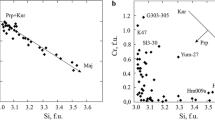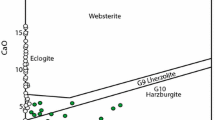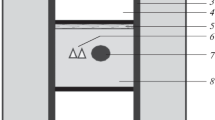Abstract
Melting experiments on a model pelitic composition yield low-spessartine garnet as an important residual phase at pressures above 7 kb. The K D values for distribution of iron and magnesium between coexisting garnet and liquid in the pelitic composition are mainly sensitive to temperature, but also have a small pressure dependence. At temperatures above 950 ° C garnet has a higher \(\frac{{Mg}}{{Mg + Fe}}\) value than coexisting liquid, but below 950 ° C the garnet \(\frac{{Mg}}{{Mg + Fe}}\) value is lower than that of the coexisting liquid. Thus at temperatures below 950 ° C silicic magmas may fractionate garnet and produce more magnesian derivative liquids.
Reconnaissance experiments with added MnO content in the model pelite demonstrate that spessartine-rich garnets are stable in silicic liquids to pressures as low as 3 kb. The MnO and CaO contents of the experimentally crystallized garnets show an antipathetic relation. Also, the grossular content of near-liquidus garnets crystallizing from a range of compositions increases with increasing pressure. The spessartine and grossular contents of most natural garnets in eastern Australian granitic rocks suggest that these garnets formed at pressures greater than 5 kb. Increased spessartine content allows crystallization of garnet in equilibrium with a silicic magma well within the pressure limit of stability of cordierite, provided the garnet contains ≧10 mol.% spessartine. Thus the depth range over which garnet and cordierite may coexist in a silicic melt is broadened, subject to the availability of MnO. The effect of increased Mn content on the low-pressure stability limit of garnet may also explain the lack of resorption of some garnets in granitic magmas, as these magmas rise to shallower levels. These euhedral garnets characteristically show zoning from an Mn-poor core (typically <4 % MnO) to an Mn-richer rim (typically >4 % MnO) and may reflect continued growth of the garnet in a low pressure regime, stabilized by Mn concentrated in the residual liquid fractions of the crystallizing magma.
Similar content being viewed by others
References
Amit, O.: Retrograde zoning in garnets of Elat-Wadi Magrish metamorphic rocks. Lithos 9, 259–262 (1976)
Birch, W.D., Gleadow, A.J.W.: The genesis of garnet-cordierite in acid volcanic rocks: Evidence from the Cerberean cauldron, Central Victoria, Australia. Contrib. Mineral. Petrol. 45, 1–13 (1974)
Chappell, B.W., White, A.J.R.: Two contrasting granite types. Pacific Geol. 8, 173–174 (1974)
Essene, E.J., Hensen, B.J., Green, D.H.: Experimental study of amphibolite and eclogite stability. Phys. Earth Planet. Inter. 3, 378–384 (1970)
Fitton, J.G.: The genetic significance of almandine-pyrope phenocrysts in the calcalkaline Borrowdale volcanic group, Northern England. Contrib. Mineral. Petrol. 36, 231–248 (1972)
Flood, R.H., Shaw, S.E.: A cordierite-bearing granite suite from the New England Batholith, N.S.W., Australia. Contrib. Mineral. Petrol. 52, 157–164 (1975)
Flood, R.H., Shaw, S.E.: Two “S-type” granite suites with low initial \(\frac{{{}^{87}Sr}}{{{}^{86}Sr}}\) ratios from the New England Batholith, Australia. Contrib. Mineral. Petrol. 61, 163–173 (1977)
Green, D.H.: Experimental testing of “equilibrium” partial melting of peridotite under water-saturated, high-pressure conditions. Can. Mineralogist 14, 255–268 (1976)
Green, T.H.: Crystallization of calc-alkaline andesite under controlled high-pressure hydrous conditions. Contrib. Mineral. Petrol. 34, 150–166 (1972)
Green, T.H.: Experimental generation of cordierite- or garnet-bearing granitic liquids from a pelitic composition. Geology 4, 85–88 (1976)
Green, T.H., Ringwood, A.E.: Origin of garnet phenocrysts in calcalkaline rocks. Contrib. Mineral. Petrol. 18, 163–174 (1968a)
Green, T.H., Ringwood, A.E.: Genesis of the calc-alkaline igneous rock suite. Contrib. Mineral. Petrol. 18, 105–162 (1968b)
Green, T.H., Ringwood, A.E.: Crystallization of garnet-bearing rhyodacite under high pressure hydrous conditions. J. Geol. Soc. Aust. 19, 203–212 (1972)
Hall, A.: The origin of accessory garnet in the Donegal granite. Mineral. Mag. 35, 628–633 (1965)
Johannes, W.: A simplified piston-cylinder apparatus of high precision. Neues Jahrb. Mineral. Monatsh. 7/8, 337–351 (1973)
Joyce, A.S.: Chemistry of the minerals of the granitic Murrumbidgee batholith, Australian Capital Territory. Chem. Geol. 11, 271–296 (1973)
Knutson, J., Green, T.H.: Experimental duplication of a high-pressure megacryst/cumulate assemblage in a near-saturated hawaiite. Contrib. Mineral. Petrol. 52, 121–132 (1975)
Kretz, R.: Kinetics of the crystallization of garnet at two localities near Yellowknife. Can. Mineralogist 12, 1–20 (1973)
Mysen, B.: Partitioning of Fe and Mg between crystals and partial melts in peridotite upper mantle. Contrib. Mineral. Petrol. 52, 69–76 (1975)
Nehru, C.E., Wyllie, P.J.: Compositions of glasses from St. Paul's peridotite partially melted at 20 kilobars. J. Geol. 83, 455–471 (1975)
Reed, S.J.B., Ware, N.G.: Quantitative electron microprobe analysis of silicates using energy dispersive X-ray spectrometry. J. Petrol. 16, 499–519 (1975)
Stern, C.R., Wyllie, P.J.: Effect of iron absorption by noble-metal capsules on phase boundaries in rock-melting experiments at 30 kilobars. Am. Mineralogist 60, 681–689 (1975)
Teale, G.S.: Thermal metamorphic schists adjacent to the Walcha Road adamellite, New England, New South Wales. Unpub. Hons. thesis, Macquarie Univ. N. Ryde, N.S.W., Australia
Warren, R.C.: Electron microprobe investigations of almandine garnets from a quartz diorite stock and adjacent metamorphic rocks, British Columbia. (Abstract.) Am. Geophys. Union Trans. 51, 444 (1970)
White, A.J.R., Chappell, B.W.: Ultrametamorphism and granitoid genesis (abstract), 25th Int. Geol. Congr. Sydney Aust. 3, 674–675 (1976)
Wood, C.P.: Petrogenesis of garnet-bearing rhyolites from Canterbury, New Zealand. N.Z. J. Geol. Geophys. 17, 759–787 (1974)
Yoder, H.S.: Generation of basaltic magma. 265 pp. Wash. D.C.: Nat. Acad. Sci. 1976
Author information
Authors and Affiliations
Rights and permissions
About this article
Cite this article
Green, T.H. Garnet in silicic liquids and its possible use as a P-T indicator. Contr. Mineral. and Petrol. 65, 59–67 (1977). https://doi.org/10.1007/BF00373571
Received:
Accepted:
Issue Date:
DOI: https://doi.org/10.1007/BF00373571




